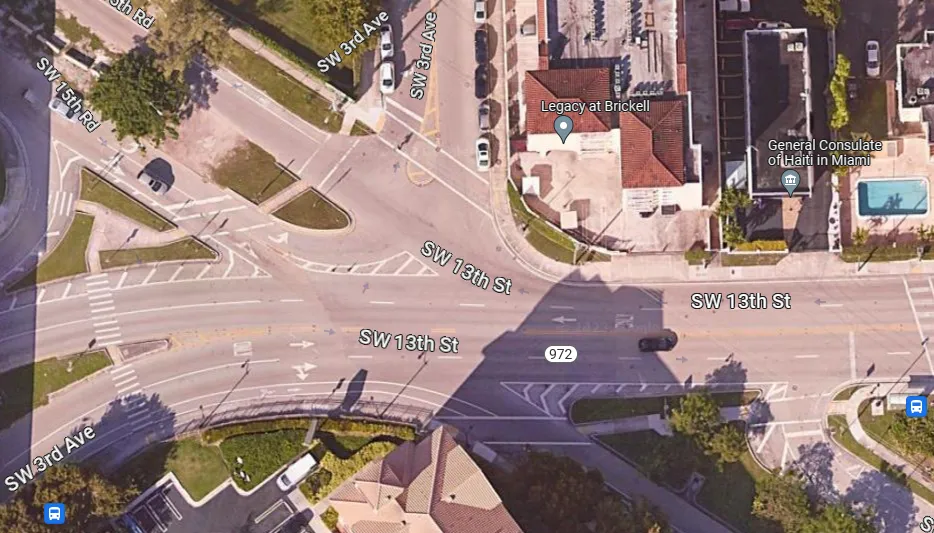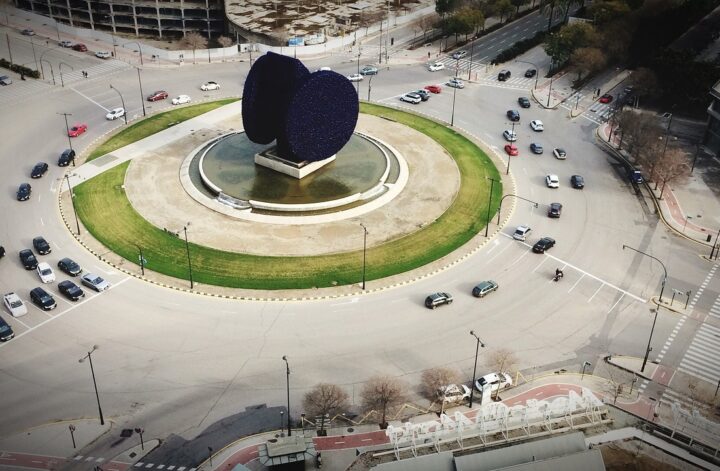If you’re a regular in the Miami neighborhood of Brickell, you know the SW 13th St. at SW 3rd Ave. intersection because of the terror it caused. You probably gripped the steering wheel as you approached it, or became your Uber driver’s second set of eyes as your heart rate went up, dividing the labor as one of you looked right and the other left, slowly inching through the intersection hoping oncoming cars didn’t crash into you.

So it was relief when we heard the roundabout at this location was being expedited by FDOT. Roundabouts are one of the most effective ways to reduce crashes and fatalities at intersections, especially weirdly configured intersections with a lot of traffic. As I learned more about the SW 13th St. design and watched construction progress, however, I became concerned. I saw that certain left turning movements within the roundabout required cars to cross 2 lanes of traffic within a very short distance. This has to do with the small radius of the roundabout and its 2 lane configuration, whereby southbound to eastbound traffic only has a few feet to make a turn from the outer roundabout lane to the inner lane in order to make a left. 2 lane roundabouts such as this one can create additional vehicular conflicts compared to single lane roundabouts.

While I do like the signals on (almost) every leg to stop traffic for pedestrians, I also noticed the oddly placed pedestrian crosswalk on the eastern leg.
Yes, there are now high visibility crosswalks on all intersection legs, but Aaron DeMayo of Future Vision Studios also had a plethora of comments on the FDOT plans.
Unfortunately, most of DeMayo’s comments suggesting a single lane, bar-bell shaped roundabout were not implemented, even though a similar roundabout was built a few miles away in Coconut Grove. The concept he proposed is a superior product compared to FDOT’s plans. Construction on the roundabout was completed a few months ago and it will be interesting to look at the crash data. While I expect injuries and fatalities to still be much lower than pre-construction, these design issues are a missed opportunity to not only address traffic conflict issues but improve the urban design of the intersection.
Not to be outdone, I also noticed Brickell’s roundabout at SE 6th Street, built several years ago, has some design issues. The lack of a pedestrian crossing on the western leg, and the swoopy south to west bypass lane are the most glaring problems. Having large segments of traffic completely bypass the roundabout defeats the very purpose of the roundabout: To slow down traffic.
I often see pedestrians walking from the west side of the S. Miami Ave bridge, realize there’s no crosswalk, and run mid-block across several lanes of traffic to get to the Brickell City Center on the east side of the roundabout. The high-speed southbound bypass lanes make this roundabout almost completely useless at slowing down traffic and improving pedestrian accessibility.
These design issues all seem to err on the side of speeding up vehicles through the roundabouts. It seems some engineers want the best of both worlds: The safety benefits of converting traditional intersections into roundabouts, and an intersection which doesn’t slow down drivers too much. Unfortunately, these two goals are incompatible with each other. The best roundabouts are those that make drivers slow down to 20mph or less because driving faster feels unsafe due to the design speed. So while it can be said that even a poorly designed roundabout is better than no roundabout at all, accommodating all pedestrian movements and dramatically slowing vehicle speeds is just as important as the decision to construct a roundabout. Let’s hope future designs take this into account.

